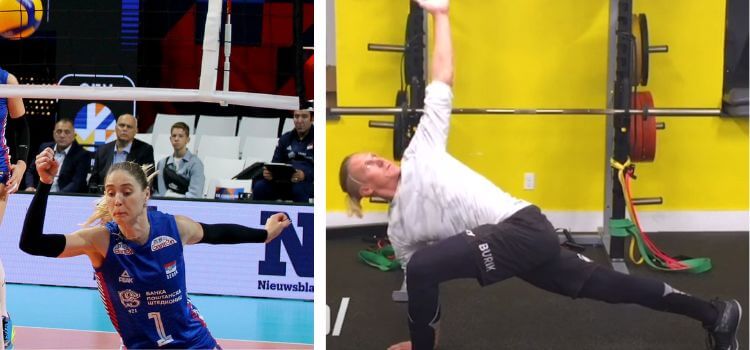As an Amazon Associate, I earn from qualifying purchases
Dynamic stretching exercises are essential for volleyball players aiming to enhance their performance and prevent injuries. Unlike static stretching, dynamic stretches involve continuous movement, which helps increase blood flow, flexibility, and muscle readiness.
In this blog post, we’ll explore the best dynamic stretching exercises for volleyball, ensuring you are fully prepared to hit the court with agility and power.
Whether you’re a beginner or a seasoned player, incorporating these stretches into your warm-up routine can make a significant difference in your game. Read on to discover the benefits and techniques of dynamic stretching tailored specifically for volleyball.
Overview of Dynamic Stretching
Dynamic stretching entails moving different parts of your body while gradually increasing your reach, speed, or both. Unlike static stretching, which involves holding a position, dynamic stretching is about continuous movement that mimics the activity you’re about to do.
Benefits of Dynamic Stretching
Injury Prevention
One of the primary benefits of dynamic stretching is injury prevention. By warming up your muscles, you reduce the risk of strains and sprains. Dynamic stretching increases blood flow and muscle temperature, making your muscles more pliable and less prone to injury.
Enhanced Performance
Dynamic stretches also help improve your performance. They prepare your body for the specific demands of volleyball, enhancing your power, speed, and agility on the court. When your muscles are properly warmed up, you’re more likely to perform at your best.
Dynamic Stretching vs. Static Stretching
Key Differences
The main difference between dynamic and static stretching is movement. Dynamic stretches involve motion, while static stretches involve holding a position.
Dynamic stretching is ideal before a game to get your body ready for action, while static stretching is better suited for cooling down after activity.
When to Use Each
Dynamic stretching involves moving various parts of your body while progressively enhancing your range of motion, speed, or both. Static stretching is best used after the activity to help with muscle recovery and flexibility.
Pre-game Dynamic Stretching Routine
Warm-up Essentials
A good pre-game warm-up should include light cardio to get your heart rate up, followed by dynamic stretching. This combination ensures your muscles are warm and ready for the explosive movements required in volleyball.
Duration and Intensity
Aim for about 10-15 minutes of dynamic stretching. The intensity should be moderate, enough to increase your heart rate and body temperature without causing fatigue.
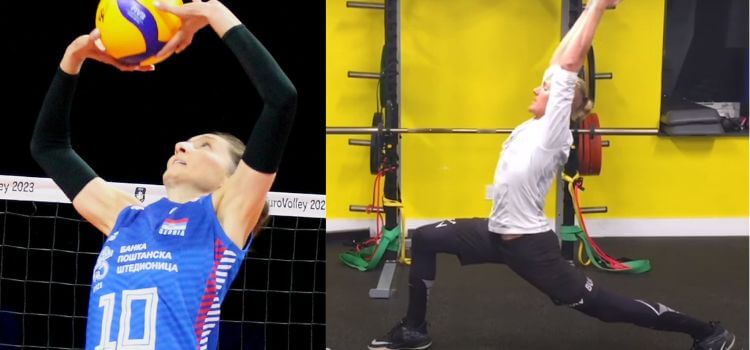
Lower Body Dynamic Stretches
Walking Lunges
Walking lunges are excellent for stretching and strengthening your legs. Step forward with one leg and lower your hips until both knees are bent at approximately a 90-degree angle.
This move targets your glutes, hamstrings, and quads.
High Knees
High knees are a great way to get your blood flowing and warm up your lower body. Run in place while lifting your knees as high as possible, engaging your core and maintaining an upright posture.
Upper Body Dynamic Stretches
Arm Circles
Arm circles are simple but effective. Extend your arms out to your sides and make small circles, gradually increasing the size. This exercise helps to loosen up your shoulder joints and increase mobility.

Shoulder Rolls

Roll your shoulders forward in a circular motion for several reps, then reverse. Shoulder rolls help release tension and prepare your upper body for the dynamic movements of volleyball.
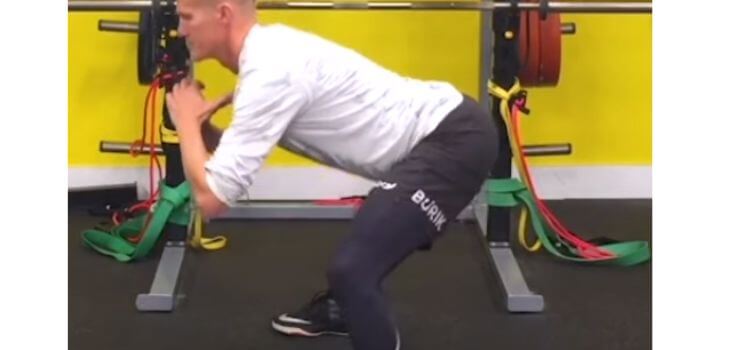
Core Dynamic Stretches
Torso Twists
Stand with your feet shoulder-width apart and rotate your torso from side to side. Torso twists warm up your core muscles and improve rotational flexibility, essential for movements like serving and spiking.

Side Bends
With your hands on your hips, bend sideways at the waist, reaching your hand down your leg. Side bends stretch the obliques and improve lateral flexibility, helping you reach for those wide passes.
Dynamic Stretches for Improved Agility
Lateral Leg Swings
Stand on one leg and swing the other leg side to side. Lateral leg swings improve hip flexibility and prepare you for quick lateral movements on the court.
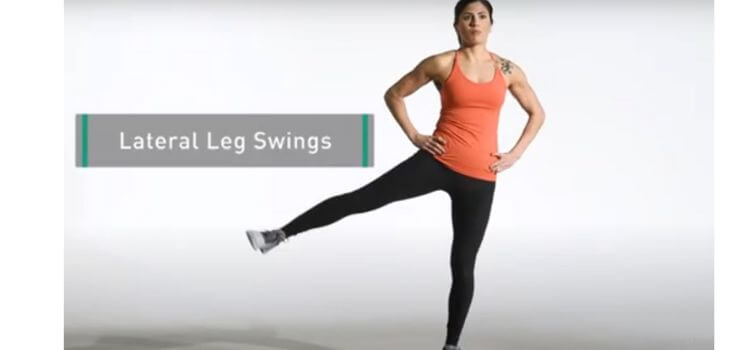
Carioca Drill
The carioca drill, or grapevine, involves crossing one foot over the other as you move sideways. This drill enhances agility and coordination, crucial for defense and quick direction changes.

Dynamic Stretches for Jumping Power
Jump Squats
Start in a squat position and explode upward, reaching for the sky. Jump squats build explosive power in your legs, essential for blocking and spiking.

Bounding
Bounding involves taking long, exaggerated steps while running. This exercise boosts your plyometric ability, helping you jump higher and move more efficiently.
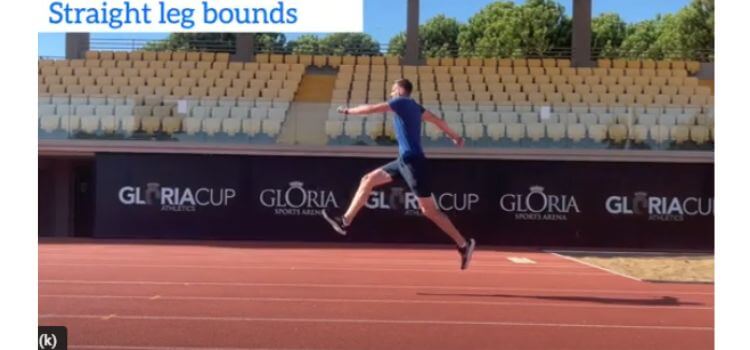
Dynamic Stretches for Serving
Arm Swings
Swing your arms back and forth, gradually increasing speed and range of motion. Arm swings prepare your shoulders and arms for the powerful motions used in serving.
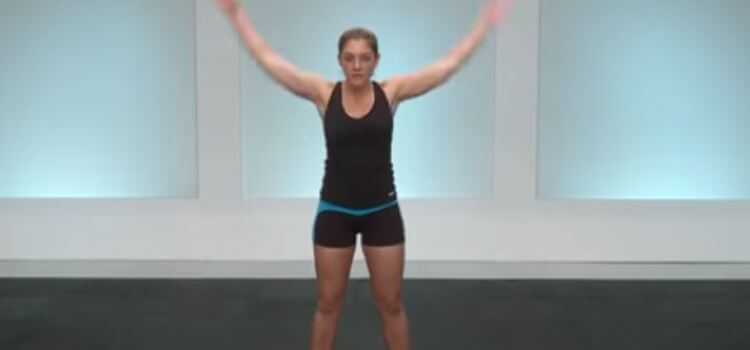
Wrist Flexor Stretch
Extend one arm in front of you, palm up, and gently pull back on your fingers with the opposite hand. This stretch targets the wrist flexors, which are crucial for a strong and controlled serve.

Cool Down After Dynamic Stretching
Importance of Cooling Down
Cooling down after your dynamic stretching routine is just as important as warming up. It helps to gradually lower your heart rate and prevents stiffness.
Effective Cool Down Exercises
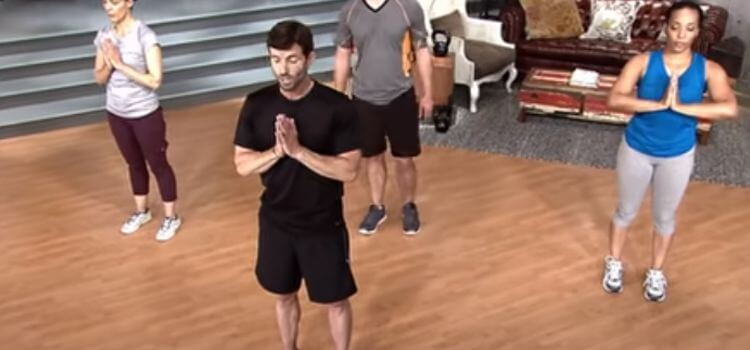
Some effective cool-down exercises include light jogging, walking, and static stretches for all major muscle groups. This helps with recovery and prepares your body for the next game or practice.
Common Mistakes to Avoid
Overstretching
Avoid pushing your stretches too far, especially if you’re not fully warmed up. Overstretching can lead to injury and defeat the purpose of warming up.
Skipping the Warm-up
Never skip your warm-up routine. Jumping straight into intense activity can increase your risk of injury and reduce your performance.
Customizing Your Stretching Routine
Assessing Individual Needs
Every athlete is different, so it’s important to tailor your stretching routine to your specific needs. Consider your strengths, weaknesses, and any areas prone to injury.
Incorporating Feedback
Listen to your body and seek feedback from coaches or trainers. Adjust your routine based on how you feel and any advice you receive.
The Role of Coaches in Dynamic Stretching
Guidance and Supervision
Coaches play a crucial role in ensuring athletes perform dynamic stretches correctly. They provide guidance and ensure exercises are done safely and effectively.
Creating a Team Routine
Coaches can also develop a standardized dynamic stretching routine for the team. This promotes consistency and ensures everyone is adequately prepared.
Advanced Dynamic Stretching Techniques
Dynamic Hip Flexor Stretch
To perform a dynamic hip flexor stretch, start in a lunge position with one foot forward and the other leg extended behind. Push your hips forward and hold for a moment, then return to the starting position.
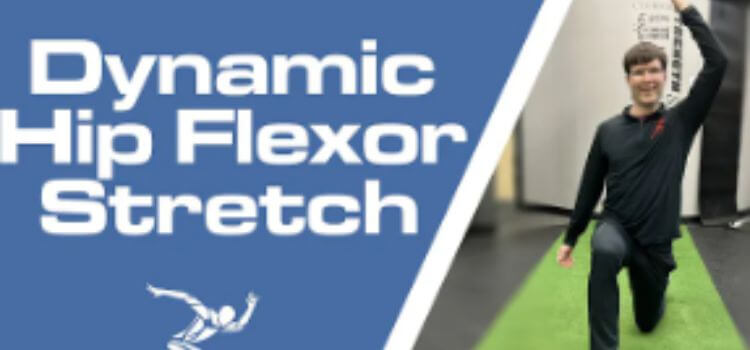
Repeat this motion to dynamically stretch your hip flexors, which are essential for powerful jumps and quick sprints.
Dynamic Hamstring Stretch
Stand with your feet hip-width apart and swing one leg straight up in front of you while keeping the other leg slightly bent. Alternate legs with each swing.

This dynamic stretch targets your hamstrings and prepares them for the explosive actions required in volleyball.
Dynamic Stretches for Enhanced Balance
Single-Leg Deadlift
Stand on one leg with a slight bend in the knee and the other leg extended behind you. Bend at the waist and reach forward with both hands, then return to the starting position. Single-leg deadlifts improve balance and strengthen the muscles in your legs and core.
Balance Reach
Stand on one leg and extend the opposite arm and leg outward in different directions, creating a star shape. Return to the center and repeat on the opposite side. This exercise enhances your balance and coordination, which are critical for maintaining stability during dynamic movements on the court.
Incorporating Dynamic Stretching into Your Training Program
Periodization and Progression
Integrate dynamic stretching into your training program with a periodized approach. Start with basic stretches and progressively incorporate more advanced techniques as your flexibility and strength improve. This method ensures continuous improvement and reduces the risk of overtraining.
Combining with Strength and Conditioning
Pair dynamic stretching with your strength and conditioning workouts to maximize its benefits. Perform dynamic stretches before strength exercises to enhance muscle activation and performance. This combination helps you build a well-rounded fitness routine that supports your volleyball skills.
The Psychological Benefits of Dynamic Stretching
Boosting Confidence
Dynamic stretching not only prepares your body but also boosts your confidence. Knowing that you’ve adequately warmed up can reduce anxiety and increase your mental readiness for the game. A well-prepared mind is just as important as a well-prepared body.
Reducing Pre-game Nervousness
Engaging in a dynamic stretching routine can help reduce pre-game jitters. The familiar movements and routine can provide a sense of calm and focus, allowing you to enter the game with a clear and determined mindset.
Dynamic Stretching for Different Volleyball Positions
Setters
Setters require quick reflexes and upper body flexibility. Dynamic stretches like arm circles, torso twists, and shoulder rolls are particularly beneficial for setters, helping them perform precise and rapid movements.
Hitters and Blockers
Hitters and blockers need powerful jumps and strong upper bodies. Exercises such as jump squats, bounding, and dynamic arm swings help these players maximize their explosive power and reach.
Libero
The libero needs exceptional agility and quick lateral movements. Dynamic stretches like high knees, lateral leg swings, and the carioca drill are ideal for enhancing the libero’s quickness and reaction time.
Monitoring and Adjusting Your Dynamic Stretching Routine
Regular Assessment
Regularly assess the effectiveness of your dynamic stretching routine. Monitor your performance and any changes in flexibility or muscle soreness. Adjust the routine as needed to address any weaknesses or imbalances.
Feedback from Coaches and Teammates
Seek feedback from your coaches and teammates to ensure you’re performing the stretches correctly and effectively. Constructive feedback can help you refine your technique and maximize the benefits of dynamic stretching.
Conclusion
Incorporating dynamic stretching into your volleyball routine is essential for enhancing performance, preventing injuries, and improving overall flexibility and agility.
By following a structured and tailored dynamic stretching routine, volleyball players can ensure that their bodies are fully prepared for the demands of the game. Remember, consistency and proper technique are key to reaping the full benefits of dynamic stretching.
FAQs About Dynamic Stretching for Volleyball
Q: What is dynamic stretching?
A: Dynamic stretching involves moving parts of your body through a full range of motion to prepare your muscles and joints for physical activity. Unlike static stretching, it emphasizes continuous movement.
Q: Why is dynamic stretching important for volleyball players?
A: Dynamic stretching helps increase blood flow, improve flexibility, and enhance muscular performance, all of which are crucial for the quick, explosive movements required in volleyball.
Q: When should I do dynamic stretching?
A: Dynamic stretching is best performed during your warm-up routine, before starting your volleyball practice or a game. It helps prepare your body for the physical demands of the sport.
Q: Can you provide examples of dynamic stretches suitable for volleyball?
A: Sure! Some effective dynamic stretches for volleyball include arm circles, walking lunges, leg swings, high knees, and torso twists. These stretches target key muscle groups used in volleyball.
Q: How long should a dynamic stretching routine last?
A: A typical dynamic stretching routine should last about 5-10 minutes, ensuring that all major muscle groups are adequately prepared for activity.
Q: Can dynamic stretching prevent injuries?
A: Yes, dynamic stretching can help reduce the risk of injuries by improving flexibility, increasing blood flow to muscles, and preparing the body for the movements involved in volleyball.
Q: Should I combine dynamic and static stretching?
A: While dynamic stretching is ideal for warming up, static stretching can be beneficial during your cool-down routine to help with muscle relaxation and recovery.

